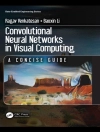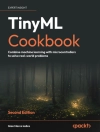This book provides an introduction to the complex field of
ubiquitous computing
Ubiquitous Computing (also commonly referred to as
Pervasive Computing) describes the ways in which current
technological models, based upon three base designs: smart (mobile,
wireless, service) devices, smart environments (of embedded system
devices) and smart interaction (between devices), relate to and
support a computing vision for a greater range of computer devices,
used in a greater range of (human, ICT and physical) environments
and activities. The author details the rich potential of ubiquitous
computing, the challenges involved in making it a reality, and the
prerequisite technological infrastructure. Additionally, the book
discusses the application and convergence of several current major
and future computing trends.
Key Features:
* Provides an introduction to the complex field of ubiquitous
computing
* Describes how current technology models based upon six
different technology form factors which have varying degrees of
mobility wireless connectivity and service volatility: tabs, pads,
boards, dust, skins and clay, enable the vision of ubiquitous
computing
* Describes and explores how the three core designs (smart
devices, environments and interaction) based upon current
technology models can be applied to, and can evolve to, support a
vision of ubiquitous computing and computing for the future
* Covers the principles of the following current technology
models, including mobile wireless networks, service-oriented
computing, human computer interaction, artificial intelligence,
context-awareness, autonomous systems, micro-electromechanical
systems, sensors, embedded controllers and robots
* Covers a range of interactions, between two or more Ubi Com
devices, between devices and people (HCI), between devices and the
physical world.
* Includes an accompanying website with Power Point slides,
problems and solutions, exercises, bibliography and further
reading
Graduate students in computer science, electrical engineering
and telecommunications courses will find this a fascinating and
useful introduction to the subject. It will also be of interest to
ICT professionals, software and network developers and others
interested in future trends and models of computing and interaction
over the next decades.
Tabella dei contenuti
List of Figures.
List of Tables.
Preface.
Acknowledgements.
1 Ubiquitous Computing: Basics and Vision.
1.1 Living in a Digital World.
1.2 Modelling the Key Ubiquitous Computing Properties.
1.3 Ubiquitous System Environment Interaction.
1.4 Architectural Design for Ubi Com Systems: Smart DEI Model.
1.5 Discussion.
Exercises.
References.
2 Applications and Requirements.
2.1 Introduction.
2.2 Example Early Ubi Com Research Projects.
2.3 Everyday Applications in the Virtual, Human and Physical World.
2.4 Discussion.
Exercises.
References.
3 Smart Devices and Services.
3.1 Introduction.
3.2 Service Architecture Models.
3.3 Service Provision Life-Cycle.
3.4 Virtual Machines and Operating Systems.
Exercises.
References.
4 Smart Mobiles, Cards and Device Networks.
4.1 Introduction.
4.2 Smart Mobile Devices, Users, Resources and Code.
4.3 Operating Systems for Mobile Computers and Communicator Devices.
4.4 Smart Card Devices.
4.5 Device Networks.
Exercises.
References.
5 Human-Computer Interaction.
5.1 Introduction.
5.2 User Interfaces and Interaction for Four Widely Used Devices.
5.3 Hidden UI Via Basic Smart Devices.
5.4 Hidden UI Via Wearable and Implanted Devices.
5.5 Human-Centred Design (HCD).
5.6 User Models: Acquisition and Representation.
5.7 i HCI Design.
Exercises.
References.
6 Tagging, Sensing and Controlling.
6.1 Introduction.
6.2 Tagging the Physical World.
6.3 Sensors and Sensor Networks.
6.4 Micro Actuation and Sensing: MEMS.
6.5 Embedded Systems and Real-Time Systems.
6.6 Control Systems (for Physical World Tasks).
6.7 Robots.
Exercises.
References.
7 Context-Aware Systems.
7.1 Introduction.
7.2 Modelling Context-Aware Systems.
7.3 Mobility Awareness.
7.4 Spatial Awareness.
7.5 Temporal Awareness: Coordinating and Scheduling.
7.6 ICT System Awareness.
Exercises.
References.
8 Intelligent Systems (IS).
8.1 Introduction.
8.2 Basic Concepts.
8.3 IS Architectures.
8.4 Semantic KB IS.
8.5 Classical Logic IS.
8.6 Soft Computing IS Models.
8.7 IS System Operations.
Exercises.
References.
9 Intelligent System Interaction.
9.1 Introduction.
9.2 Interaction Multiplicity.
9.3 Is Interaction Design.
9.4 Some Generic Intelligent Interaction Applications.
Exercises.
References.
10 Autonomous Systems and Artificial Life.
10.1 Introduction.
10.2 Basic Autonomous Intra-Acting Systems.
10.3 Reflective and Self-Aware Systems.
10.4 Self-Management and Autonomic Computing.
10.5 Complex Systems.
10.6 Artificial Life.
Exercises.
References.
11 Ubiquitous Communication.
11.1 Introduction.
11.2 Audio Networks.
11.3 Data Networks.
11.4 Wireless Data Networks.
11.5 Universal and Transparent Audio, Video and Alphanumeric Data.
11.6 Ubiquitous Networks.
11.7 Further Network Design Issues.
Exercises.
References.
12 Management of Smart Devices.
12.1 Introduction.
12.2 Managing Smart Devices in Virtual Environments.
12.3 Managing Smart Devices in Human User-Centred Environments.
12.4 Managing Smart Devices in Physical Environments.
Exercises.
References.
13 Ubiquitous System: Challenges and Outlook.
13.1 Introduction.
13.2 Overview of Challenges.
13.3 Smart Devices.
13.4 Smart Interaction.
13.5 Smart Physical Environment Device Interaction.
13.6 Smart Human-Device Interaction.
13.7 Human Intelligence Versus Machine Intelligence.
13.8 Social Issues: Promise Versus Peril.
13.9 Final Remarks.
Exercises.
References.
Index.
Circa l’autore
Stefan Poslad holds a Ph D in computing from the University of Newcastle upon Tyne, UK. He is currently a lecturer and a researcher in the Intelligent Communication Lab at QMUL He has extensive experience at developing and delivering course material in related areas and at applying ambient intelligent approaches involving agents, context aware, smart mobile devices and sensors.
Michael Berger has been involved in Computer Science research for the last 12 years, specializing in Computer Supported Cooperative Work (CSCW), Distributed and Ubiquitous Systems as well as Multi-Agent Systems research.? Since 1997 Dr. Berger is a member of the Intelligent Autonomous Systems research group at Siemens Corporate Technology (CT) in Munich and is involved in several technical and team management functions, responsible for product developments in the telematics area and chair of several activities. Since 2002 Dr. Berger has been heading the technology and competence field ‘Mobile and Ambient Intelligence Technologies’ within Siemens CT.
Robert M. Patton is a research associate with the Applied Software Engineering Research group of Oak Ridge National Laboratory.? He is currently the principle investigator of the Orion Project, which focuses on the application of intelligent software agents for sensor data fusion. In addition, Dr. Patton works on a number of different projects involving software agents, computational intelligence, and applications to information fusion.
Patricia Charlton has over 15 years of research experience in the field of Artificial Intelligence and Multi-Agent systems. This experience covers all aspects from project inception and proposal, through design and implementation, on to end user studies and field trials of the systems developed. This includes being prime coordinator of two large EU projects. Experienced in strategic, management and technical roles within Motorola Labs and author of over 50 papers in the field of AI and multi-agent systems and of 9 filed patents.












